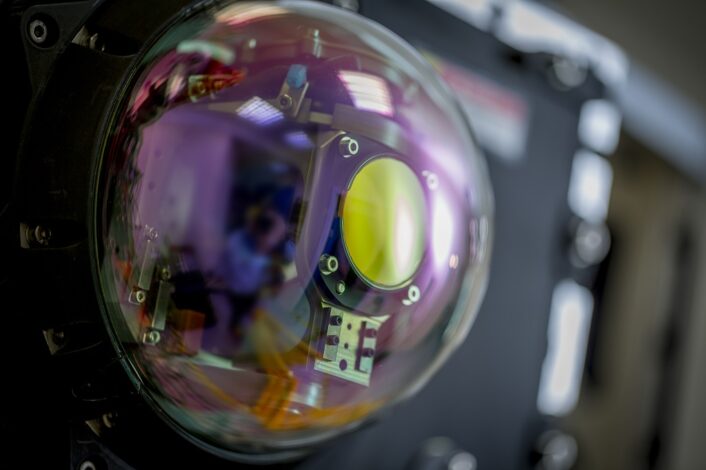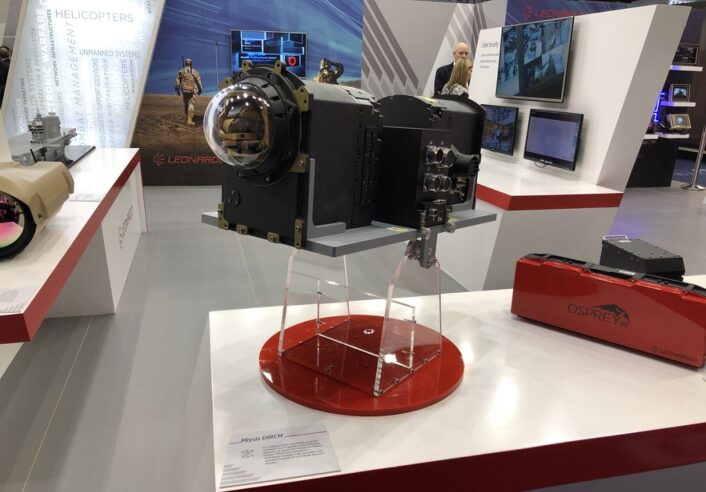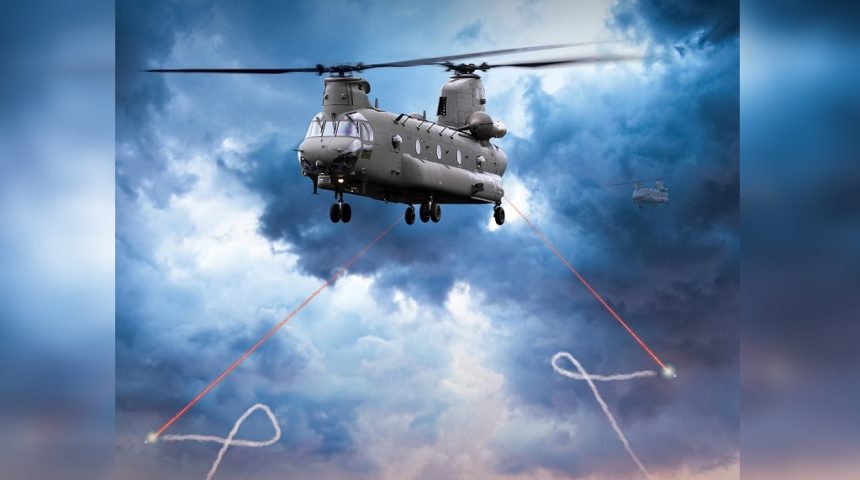The Miysis DIRCM, already operational with multiple customers, is built on the company’s expertise on laser and electro-optic pointing and stabilisation systems.
MAN-Portable Air-Defense Systems (MANPADS) are among the the biggest threats for low-flying aircraft: these systems are both cheap and lethal and thus easily found in the hands of militants (with the Soviet-era 9K32 Strela-2 (SA-7 “Grail”) and 9K310 Igla-1 (SA-16 “Gimlet”) and the Chinese FN-6 Hongying-6 being among the most common). The lessons learned from conflicts over the past 40 years demonstrated the need to protect aircraft from this kind of threat, with a particular focus on helicopters, since they are more exposed to it due to their low speed.
Through the years, we have observed an increasing usage of Missile Warning Systems (MWS) aboard air assets and, during the last decade, almost all western aircraft deployed for combat operations were at least equipped with ultraviolet-based MWS to detect incoming missiles. With MANPADS becoming more sophisticated, the traditional countermeasures, better known as flares, used against these threats, are becoming less and less effective.
Since the 2000s, a combination of UV MWS, flares and Directional InfraRed Counter Measures (DIRCM) started to become increasingly common, especially on helicopters which were the first to be equipped with the new defensive technologies. DIRCM is usually based on directed-energy weapon technologies, which provide stronger effects against a threat while also removing the limitation posed by the number of flares that can be carried and used by an aircraft.
One of the first DIRCM systems to be developed was the Northrop Grumman AN/AAQ-24 Nemesis, in the works at least since 1995 and fielded in the early 2000s on over 50 aircraft types. Even Russian forces had to invest in these technologies following their recent experience in Syria, developing and deploying the Vitebsk BKO L370, more commonly known with its export designation President-S.
Leonardo was among the partners in the AAQ-24 Nemesis program, providing laser pointer/trackers for over 2,500 units. The company has been a global leader in the design, development, manufacture and support of airborne laser and electro-optic pointing and stabilisation systems (including components for the F-35’s EOTS, AH-64’s M-TADS, Sniper and Litening targeting pods) for over 40 years and used the experience acquired in this sector to develop its own DIRCM system, called Miysis.
What is Miysis?
Miysis is a low-power-draw, low-weight DIRCM designed to provide high-power, all-aspect protection against modern and legacy threats. Miysis features a twin-head laser pointer/tracker system as a single head DIRCM does not provide the necessary level of spherical protection to defeat more advanced threats. In fact, the airframe would mask some angles and create shadow zones where the DIRCM would not be able to “see” the threat, putting the aircraft at risk. The company says that a three-head system is also available for coverage on large platforms with high-value missions.
David Gourlay, Head of Leonardo’s DIRCM campaigns and former Tornado weapon systems officer in the Royal Air Force, provided an example to better explain the need for a twin-head system: “If you are flying level and you have a single DIRCM system underneath your aircraft, it can see left and right, but as soon as you manoeuvre your aircraft, one side is blanked. So, if you are equipped with a single head system, if you do any sort of tactical manoeuvring you generate that big blanking area leaving that side unprotected.”
The development of Miysis capitalised heavily on key IR sensor, laser and sightline control technologies made available from Leonardo’s internal advanced technology investments, combined with the latest open-architecture system concepts and MOTS/COTS (Military Off-The-Shelf/Commercial Off-The-Shelf) hardware. The open architecture design readily supports the integration of Miysis on any aircraft, either as a stand-alone DIRCM solution or as part of a broader Defensive Aids Suite (DAS), as well as allowing a quick integration with the accompanying Missile Warning System.

The company set itself three key technical challenges for the development of the Miysis DIRCM system in terms of weight, laser power and speed of response. In order to be suitable for light aircraft, small helicopters and UAVs, Miysis had to be small, lightweight and draw very low power from the host aircraft, while at the same time delivering enough laser power onto a threat to protect even larger airframes. Moreover, the DIRCM had to engage any IR MANPAD threat immediately after launch, regardless of the range from which it was fired.
In fact, the primary goal of the DIRCM is to completely deny missile guidance and cause the MANPAD to miss by a very large distance and as early in the engagement as possible, in order to create the largest possible miss distance. The ability to jam a missile as soon as possible is also instrumental to allow a multiple threat scenario to be defeated effectively, even with only one laser firing on multiple targets. As an example, we can consider two missiles launched on the same side of the aircraft, so only one DIRCM turret would be able to see and engage them.
Leonardo believes that the Miysis DIRCM System is currently the smallest and lightest high Energy-on-Target, multi-turret, full DIRCM system available to the world market today, with a total system weight of less than 40 kg (excluding the MWS). It has a peak power draw of less than 1300W, and typically draws less than 600W during jamming with both heads, giving it the lowest aircraft power requirements of any comparable system.
The functioning mechanism can be explained as follows: when a missile is launched, the MWS sensors detect the IR-signature of its rocket motor. The control unit then cues the DIRCM to the detected IR-track, quickly examining it to determine if it presents a threat to the aircraft. If the track is recognized as an immediate danger, the DIRCM begins the jamming action directing its laser energy on the missile’s seeker, disturbing its guidance as needed to protect the aircraft.
The baseline Miysis DIRCM System comprises two integrated Laser Pointer/Trackers, a Single ruggedised COTS Control Electronics Unit and a Cockpit Interface Unit, and can be either installed directly in the airframe or in an external pod. The system as described is then integrated with a separate DIRCM-capable MWS, which is chosen by the customers according to their requirements. Miysis has already been tested with six different MWS systems, whose quick integration has been significantly simplified thanks to open architecture interfaces.
The DIRCM-capable prefix is important, as generally the MWS requires a number of modifications to optimise its performance within a DIRCM System. For example, a rapid threat declaration is essential to minimise the time between missile launch and jamming laser energy hitting the missile’s seeker, especially for short range missile engagements. This requires significant changes to the software, resulting in a rapid, high probability of detection at the expense of a higher false alarm rate.
This would be completely unsuitable for a legacy countermeasure system, as it could waste precious flares that are carried in a limited quantity on the aircraft. However, DIRCM uses a high-resolution sensor to acquire the detected IR-track and confirm it as a threat, resulting in an extremely high probability of detection with a very low false alarm rate. Moreover, because the laser output is not a finite resource as flares are, the benefits of early jamming of a potential threat compensate the potential downside of jamming a false target.
Talking about the other components, integrated Laser Pointer/Trackers each feature a Type 160 multi-band IRCM laser, a compact, high efficiency, multi-band, multi-watt output Thulium Fibre pumped Ho:YAG/ZGP laser which is the result of many years of technology investment by Leonardo in collaboration with the UK DSTL (Defence Science and Technology Laboratory). The DIRCM System Control Electronics Unit can be considered the brain of the entire system, as it undertakes all the necessary system level processing, including control, threat prioritisation and hand-over of IR-tracks from the MWS to the DIRCM System.
In a presentation from a couple of years ago, Leonardo included a more technical representation of the inner working of the DIRCM: “DIRCM systems defeat IR MANPADS by injecting modulated laser energy directly into the threat missile seeker, disrupting the seeker tracking and guidance algorithms, preventing the threat missile from tracking its target and often inducing a false guidance signal for the missile.” Obviously, since the countermeasures used against IR-guided MANPADS is the same as that for IR-guided air-to-air missiles, a DIRCM like Mysis would be also effective against the latter.
Four main parameters contribute to the rapid disruption of missile guidance:
- The Time to achieve effective Energy on Target (TEoT);
- The magnitude of the incident Energy on Target (EoT);
- The effectiveness of the jamming code;
- The effective coverage over the missile engagement envelope.
The TEoT is a combination of the time taken for the MWS to detect the threat and pass the information to the DIRCM, and the time taken for the Pointer/Tracker to acquire the threat and commence laser firing. Using simpler terms, we can define the TEoT as the DIRCM’s reaction time, so it obviously needs to be minimised. The EoT capability is yet again a combination of multiple elements, including the actual laser beam characteristics and the system laser sightline tracking accuracy. Contrary to the TEoT, this parameter needs to be maximised. As mentioned by the company, against the latest generation of MANPADS and/or multiple shots, it has been demonstrated that “faster is better and higher energy is better”.

In order to be jammed, each IR-seeker needs a different laser modulation precisely matched to its guidance characteristics. The laser jamming code that controls this modulation needs to be “universal” and effective against a full range of operationally fielded threats within the shortest possible engagement periods. The last, but not least, parameter is the coverage provided by the DIRCM and MWS systems, which needs the greatest possible MWS Field of Detection and Laser Pointer/Tracker Field of Engagement as today’s advanced IR MANPADS can attack from any aspect and not just from the rear.
Some background
Miysis was first launched in February 2013 by Selex ES, one of the companies that were later merged into Leonardo, during the biennial International Defence Exhibition & Conference (IDEX) in Abu Dhabi.
The new DIRCM was successfully demonstrated in March 2014 as part of NATO Trial EMBOW XIV, with extensive ground test and evaluation at the French Direction Générale de l’Armement (DGA) laser range at Cazaux followed by flight testing on a DGA CASA 212. The Miysis DIRCM system autonomously acquired, tracked and jammed the trial test equipment on the ground, demonstrating rapid and effective capability to jam operationally representative threats, from the initial MWS acquisition through hand-off, acquisition and track to laser firing and modulation.
Few months later, in May 2014, Leonardo supported the multi-national SALT II (Surface-to-Air Launch Trial II) missile live-fire trial hosted by the Defence Materiel Administration (FMV) at Vidsel (Sweden). For this trial, Leonardo demonstrated the Miysis DIRCM system integrated with the Saab MAW 300 Missile Approach Warners, both installed in a RUAG pod. During the trial, all the MANPADS missiles fired were acquired, handed-off and tracked with the required accuracy.
In 2016, the Miysis DIRCM Design Verification and Qualification programme was completed. The two primary elements of this programme were the Qualification Testing, which proved that Miysis operates across a fully representative environment as defined by appropriate military standards, and the Design Verification Testing, which proved that the design system performance levels are achieved and maintained throughout the qualified environment.
During the same year, several customers performed Independent Verification and Validation testing (IV&V) to confirm the results obtained by Leonardo. In addition to that, Leonardo supported a UK MoD sponsored live-fire activity to demonstrate a complete, operationally representative, UK NDAS-compatible (NATO Defensive Aids System) Electronic Warfare (EW) System. This system, integrated into a pod supplied by Terma, featured the Thales UK Elix-IR MWS, Leonardo Miysis DIRCM and EW Controller, an N-DAS/SCI-260 compatible architecture and an operationally representative test jamming waveform developed by the DSTL.
In November 2017, Miysis was selected as part of the Block IV Aurora modernisation programme for the Royal Canadian Air Force’s fleet of 14 CP-140 Aurora (Canadian designation of the P-3 Orion) maritime patrol aircraft. Leonardo has been contracted to supply an unspecified number of systems, with each one comprising the twin turret Miysis coupled with five Hensoldt AAR-60 Block 2 MILDS missile warning sensors. The Initial Operational Capability was set for June 2020, while the Full Operational Capability is planned for September 2022, allowing the CP-140 fleet to remain operational until the 2030s.
During the Farnborough International Airshow 2018, Leonardo has announced that it has secured a contract with an unspecified customer in the Middle East region for Miysis. No further details were made available. Later that year, in October 2018, Leonardo and Thales have announced that the combined Miysis and Elix-IR missile warning and protection system has been proven highly effective during live-fire scenarios as part of SALT III hosted by FMV at Vidsel. The two systems, integrated through Leonardo’s DAS Controller aboard a Terma Universal DIRCM pod, demonstrated the capability to quickly defend against incoming IR-guided surface-to-air missiles thanks to the optimised “threat-warning/threat-defeat chain“.

In September 2019, the UK MoD contracted Leonardo and Thales to deliver an integrated UK Defensive Aids System that will equip the RAF’s fleet of eight Shadow ISTAR (Intelligence, Surveillance, Target Acquisition and Reconnaissance) aircraft. The aircraft, which are based on the King Air 350CER and operated by 14 Squadron out of RAF Waddington, are undergoing major upgrades with Initial Operating Capability targeted for this year. The complete system features the Thales Elix-IR Threat Warner, Leonardo DAS Controller, Leonardo Miysis DIRCM and Thales Vicon Countermeasures Dispensing System.
During IDEX 2021, Leonardo disclosed that there is an ongoing strategic marketing campaign for Miysis for the UAE military, as well as for other customers in the Middle East. As a matter of fact, in June the company announced a contract to provide its DIRCM for an unspecified Middle Eastern government customer’s new VVIP transport aircraft. According to the press release, Miysis will be installed on a Bombardier Global 7500 aircraft, reportedly the first of its type to be selected by a government customer, and is expected to become operational in 2022.
In September, Leonardo has signed a Strategic Partnering Arrangement (SPA) with the Royal Air Force, Defence Equipment & Support (DE&S) and the DSTL to further develop platform-level integrated protection systems for British aircraft. The system, which will have to meet the challenges of the future as well as the threats of today, will be based around the Leonardo Modular Advanced Platform Protection System (MAPPS) controller, which exploits the NATO Defensive Aids System (NDAS) standard.
The final system will incorporate equipment that can detect, identify and defeat threats to an aircraft, with specific countermeasures being Miysis and another Leonardo product that we covered in a detailed story, the BriteCloud Advanced Expendable Active Decoy, which will protect the aircraft from radar-guided threats.
During the same month, Leonardo started the series production of the new MAIR (Multi Aperture InfraRed) threat warning system, with first deliveries due to start in 2022 for installation on Italian Army helicopters. MAIR is described as a “distributed aperture” threat warning system, which fuses data from between four and six infrared cameras to simultaneously detect and track incoming missiles, as well as hostile gunfire threats, via their heat signatures.
MAIR and Miysis are considered complementary systems and MAIR’s rapid response time and accurate tracking at long range have been proved during a successful trials campaign. The company has already conducted successful integration tests in the DIRCM System Integration Laboratory at Edinburgh to prove that the systems can work seamlessly together. This way, Leonardo can also deliver a complete IR threat-warning/threat-defeat system incorporating both MAIR and Miysis without involving third parties, if required by a customer.
The Aviationist would like to thank Leonardo’s spokesperson John Stevenson and the company’s team of experts for the help provided in the preparation of this article, while making sure also that it would not compromise sensitive information that would preclude the safety of the aircraft and crews employing this advanced technology.









